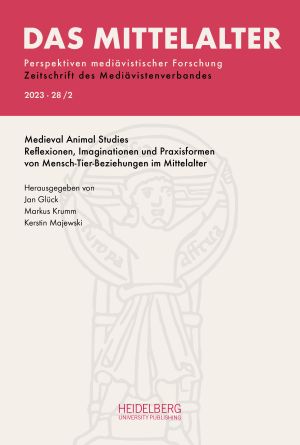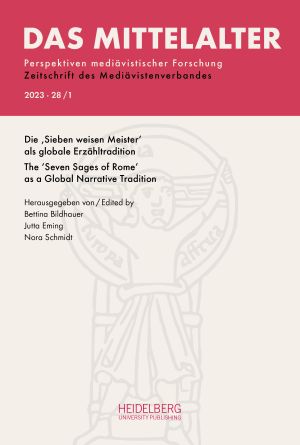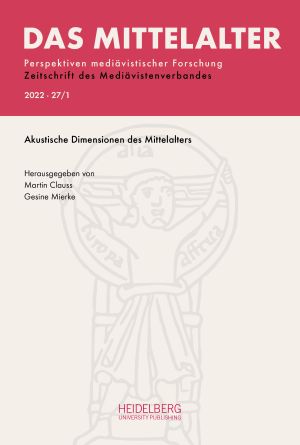Archives

Übergänge. Geburt und Tod als liminale Zustände im Mittelalter
Vol. 29 No. 2 (2024)
While medieval studies have long devoted great attention to the phenomena of birth and death, this special issue for the first time focuses on their close connection in the realm of medieval thought, experience, and practices. Drawing on theories of rites of passage and liminality, the collected studies examine the symmetry of birth and death in literary, religious, social, and medical concepts and actions. The topics range from strategies for coping with high mortality rates during childbirth, to forms of burial and grave goods, and even the reception of Eastern reincarnation doctrines in late medieval Europe.

Verschränkte Welt. Medien, Modelle und Diskurse mittelalterlicher Meteorologie
Vol. 29 No. 1 (2024)
Meteorological phenomena were not only a constant companion of people in the Middle Ages: Wind, rain, lightning and other atmospheric phenomena could affect and determine the existence and survival of individuals and communities. Above all, it was the fact that these phenomena were seen as the result of an entanglement of the visible reality of ‘meteors’ and the less visible cosmological structures of the universe that prompted people in the Middle Ages to explore meteorological phenomena. This special issue brings together a series of interdisciplinary contributions in the field of medieval studies that show how such phenomena were the starting point for theorising in different cultures.

Medieval Animal Studies. Reflexionen, Imaginationen und Praxisformen von Mensch-Tier-Beziehungen im Mittelalter
Vol. 28 No. 2 (2023)
What is the position of interdisciplinary Medieval Studies within current trends in Animal Studies? What potential do the methods, theorems, and critical reflections of Animal Studies have for the analysis of medieval sources? What contribution can decidedly Medieval Animal Studies make to contemporary discussions and conceptualisations? With these questions in mind, the studies in this issue focus on reflections, imaginations, and forms of practice of human–animal relations in the Middle Ages, which they discuss from different disciplinary perspectives and thus contribute to a historicisation of the concepts of contemporary Animal Studies.

Die ‚Sieben weisen Meister‘ als globale Erzähltradition/The ‘Seven Sages of Rome’ as a Global Narrative Tradition
Vol. 28 No. 1 (2023)
The ‘Seven Sages of Rome’ was one of the most widely distributed story matters of premodernity. It was transmitted in at least 30 languages from Arabic to Russian across Asia, Europe and the Middle and Near East from the 11th to the 19th centuries. Nevertheless, this tradition is still little known and rarely researched in Mediaeval Studies. This special issue proposes that the ‘Seven Sages of Rome’ is ripe for rediscovery, and for bringing together and giving new perspectives on current and interdisciplinary approaches in Mediaeval and Early Modern Studies. This includes transmission studies, intersectional analysis and global approaches to literary history.

Die Materialität von Kredit. Sachüberlieferungen mittelalterlicher Schuld- und Kreditbeziehungen
Vol. 27 No. 2 (2022)
This special issue provides an overview of the diversity of the materiality of credit relations in Central, Northeastern, and Southeastern Europe. In nine case studies dealing with different kinds of objects like tally sticks, letters and pawn objects, it is shown that credit was not limited to a specific social or economic stratum. The different approaches stemming from archeology, German philology, Jewish studies, and material studies offer new insights into the functioning of medieval credit practices. Given the growing research interest in economic changes in the Middle Ages, the articles make a valuable addition to sources available for economists and historians alike.

Akustische Dimensionen des Mittelalters
Vol. 27 No. 1 (2022)
This volume takes on various acoustic dimensions of medieval literature, historiography, music and art from different disciplinary perspectives. This way, an aspect of the epoch that has received little attention so far comes into focus. The topics covered range from the sounds of Olifant to the silence of mysticism to late medieval pulpits.

Mediävistik 2021. Kinderlosigkeit im Mittelalter
Vol. 26 No. 2 (2021)
Childlessness is mentioned in numerous medieval sources; coping strategies included medical, religious, and social measures. Although the social consequences of infertility could be severe, especially for women, quite a number of people decided to remain without offspring. Voluntary or involutary childlessness was of major importance during the Middle Ages, in contrast to previous suggestions in the literature. By looking at a complex web of sociability, religion, and desire through the lens of childlessness, the eight interdisciplinary studies collected in this issue illustrate the complexity, diversity and multiplicity of historical concepts of gender, body, and family.

Mediävistik 2021. Positionen, Strategien, Visionen
Vol. 26 No. 1 (2021)
The Mediävistenverband has recently changed its publication policies, adopting open access as the way to be followed in the future. On this occasion, this first volume published under the new circumstances takes a look at the situation of medieval studies in 2021, developing new strategies which may guide our future work. Members of the presidency and of the advisory board combine their expertise to explore some of the main academic, political and social issues. At the outset, six strategic papers discuss the relevance of medieval studies, problems related to the use of the term “middle ages”, challenges faced by young scholars while developing their career options, new possibilities opened up for research communication, digital humanities in medieval studies as well as advantages and disadvantages of large research centres. These interdisciplinary essays are complemented by shorter texts, each discussing one medieval discipline individually, covering the whole range from archaeology to Scandinavian studies and theology, including the important interrelationship of medieval studies and secondary education. In the third part, the reviews focus on digital publications in medieval disciplines.
